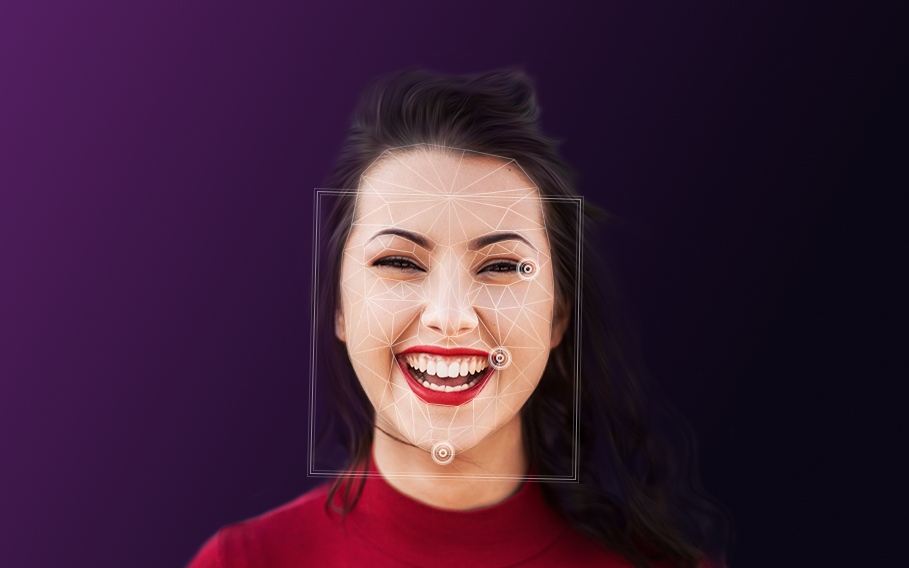
Are we living in a bad sci-fi movie or the dawn of a new technological age? Depends on who you ask. The rise of artificial intelligence, machine learning, and facial recognition technology is rapidly changing our world, and our everyday lives.
Have you noticed that Facebook is now able to tag your friends in photos with great accuracy? Or that certain smart phones can organize your photos by identifying individual people in the photos? Yep. That’s facial recognition in action. Other examples range from airport security agents using it to identify fake passports, to casinos using it in security cameras to prevent people from cheating, and large retailers using it to identify customers via video surveillance, and personalize offers based on detailed knowledge of their buying preferences.
There’s no question that a growing number of industries are turning to facial recognition as a smarter, faster, and more advanced solution to problems that were previously more challenging and time consuming to solve. (In fact, it’s estimated that by 2022, the facial recognition market will reach 9.6 billion dollars.) The ad industry in particular, is one of the sectors leading the charge in implementing the technology into its business processes, and experts are already predicting how it will permanently change the landscape of marketing and advertising as we know it.
What will facial recognition technology allow marketers to do?
“Facial recognition will allow marketers to effectively know their customers better,” says Artem Kukharenko, CEO of Ntechlab, a major player in the facial recognition field. In retail stores for example, “visitors’ photos may function as cookies referring to the identification and storage of user settings. In other words, loyalty cards will become obsolete. As soon as you walk into a store, the staff will already know what you bought the last time you were shopping there, thanks to the camera’s footage and our technology.”
To a certain extent, this is already happening. Have you ever noticed that after you search for a certain item on the internet you’re almost immediately inundated with ads for that item? It happens all the time on retail and social media sites. Consumers are offered targeted deals, or are presented with similar items or content based on their search/viewing history.
In the future, according to Molly Reynolds at Inc, “Every advertisement you see, whether you know it or not, will be 100 percent targeted to you and your interests,” - and this future is not too far away. Reynolds says, “When marketers can use Big Data, whether through online transactions or in store preferences, they can create almost entirely targeted campaigns, down to a single customer. We’re not just talking about re-marketing here, but an AI technology that can pretty much read your mind - well, at least your face.” What was once only seen in sci-fi movies is quickly becoming our reality.
Who is using facial recognition in advertising?
One big brand that has already leveraged the technology in their advertising is Nike. In 2012, the shoe giant launched their “Nike Free Face” campaign, which allowed people to control the movements of virtual Nike shoes with their facial expressions, demonstrating the flexibility of Nike footwear. The app captured users’ facial expressions via webcam, and allowed them to bend, twist, and squish the sole of the shoe using their face. The innovative campaign was a hit, and was one of the first to shine a light on how facial recognition technology could open up a new world of creative marketing and advertising strategies.
Another leading brand that has experimented with facial recognition is Virgin Mobile. In 2013 the company launched their “Blinkwashing” campaign; a “choose-your-own-adventure” video campaign that allowed viewers to change the storyline in a video clip with a blink of an eye. Viewers could “click” through scenes featuring a gorilla doing sign language in the kitchen, a talking penguin, and more - just by blinking.
“The technology allowed users to be part of a visual effect they’d normally only be able to observe passively,” says Tom Labree, strategy partner at Rehab Studios, “giving them deeper understanding of the ad.”
The startup OfferMoments is hoping to revolutionize media buying with their new retail-based digital billboard that uses "facial recognition and mobile data technology to personalize offers as consumers approach it." Upon downloading an app, shoppers can see their faces on the billboard screen, along with personalized deals for local shops nearby. Retailers that want to advertise with the technology can purchase ad space through in-app programmatic bidding - eliminating the need to bring in a media agency. OfferMoment's founders believe that their tech will revolutionize out-of-home-planning, allowing smaller companies to buy out-of-home spots at a much more affordable price.
“It’s also about accountability,” says co-founder, Abdul Alim. “You’ll know who is seeing what adverts at what time, and you’ll be able to see who responded to them and converted. With traditional billboards, one million people could see your ad, but you’ll never know who went and purchased because of it.”
The major concern for companies like OfferMoments is that people are still hesitant to use facial recognition to shop.
According to a 2015 First Insight Survey, “Seventy-five percent of consumers would not shop at a store using facial recognition technology for marketing purposes.” However, the same study found that 55 percent would be open to facial recognition if they knew there was a benefit involved, like getting a discount.
How accurate is facial recognition?
Facial recognition software is becoming increasingly more accurate as it continues to evolve, however, as with all other technologies, there have been some bumps along the way. For example, in recent years some facial recognition programs have received backlash for mis-identifying people of color. In his article, “Can Apple’s Iphone-X Beat Facial Recognitions Bias Problem,” Wired writer Klint Finley discusses the reasons for this; mainly that these facial recognition programs were not given enough dark-skinned faces to analyze while the algorithm was being developed.
Many companies have since learned from other’s mistakes however, and are making sure that their facial recognition programs are trained with more diverse samples of faces.
Apple, for example, is planning to launch what they claim is an exceedingly accurate facial recognition program with the release of the new iPhone X this fall, which comes with Face ID - facial recognition that allows users to unlock their phone with their faces. According to Apple, the new iPhone is more secure than their previous iPhones, which used Touch Id. Apple claims the that odds someone could unlock the new iPhone X (i.e. trick the system) are 1 in 1 million (compared to 1 in 50,000 for Touch Id).
Furthermore, the company says that Face Id will also work in the dark, and can identify you even if you’re wearing sunglasses or a hat.
Of course we’ll have to wait until the iPhone X’s release in November to see how well Apple’s facial recognition works, but either way, the phone’s release marks another major milestone in the continued evolution of the technology.
How facial recognition is making advertising more effective
Facial recognition has already started revolutionizing the ad industry, and its use will only become more widespread as advertisers strive to further personalize and humanize the marketing experience.
More recently, the industry has started taking facial recognition one step further by using it to develop another big emerging tech in advertising: predictive analytics. Dumbstruck, for example, is a web-based video analytics platform that can test the effectiveness of marketing videos through facial recognition and advanced machine learning. Once a video is uploaded to the platform, it's sent to targeted demographics, and then the technology tracks the emotions viewers experience for every moment of the video.
The platform is unique in that it allows users to see how audiences react to their ad before even running a campaign, giving advertisers the opportunity to refine the campaign so that it produces a higher ROI. For example, users can:
-
Tweak content so that it more effectively drives the desired response and behavior from their audience.
-
Use the data to identify which demographics responded best to the ad and adjust their media spend accordingly.
-
Test different campaigns to see which one is more effective.
- See how well competitor ads are performing in their industry.
The ability to test ad content with target audiences allows advertisers to receive valuable consumer insight that can make campaigns more effective and successful - without the extra cost of an in-person focus group.
Facial Recognition is the future of advertising, and civilization as we know it
The idea of facial recognition as a sci-fi, futuristic technology is quickly fading - if not gone altogether. The reality is that facial recognition is already here, and it’s only going to continue to become smarter, faster, and more widely used, especially in the advertising industry.
There are skeptics who argue that facial recognition perpetuates a “Big Brother is Watching You” consumer market, but in reality the technology’s purpose in advertising is to create marketing and shopping experiences that are tailored to consumers’ personal preferences, with the goal of making advertising less disruptive and more appealing to what people actually want.
Tom Labree at Rehab’s Studio suggests that future consumers will be much more “astute” when it comes to facial recognition. “They will see data as something they own and not something they make,” he says, “and thus giving their data away will become much more of a trade off: ‘Will giving this data to this brand enhance my life or give me a better experience? As for it being Big Brother or not, facial recognition can tell a lot less about you than your mobile phone.”
Facial recognition experts are also firm in their belief that the technology is changing the world in a positive way. “This isn’t Big Brother, we are just trying to help people have an easier time with their life,” says Lyndon Smith, from Bristol Robotics Laboratory, a company doing cutting edge research in the field and using 3D imaging to create much higher levels of accuracy. The company hopes to use their facial technology to make the process of checking in at airports easier, and to be able to identify passengers without stopping them at train stations.
Smith is optimistic that people will accept the technology but it’s going to take time. He says, “Anything new, people are understandably a bit wary about, but I think as soon as people realize that this is just something to help them with their lives and then they realize the benefits of not having to mess around with the old ways, they will probably accept it. Who wants to do something laborious when you can do something easy that will accomplish the same thing?”
As facial recognition becomes more accessible and easier to use, people will increasingly trust the technology, and eventually, just like the internet and Touch ID, it too will become a commonplace tool that we use every day.







